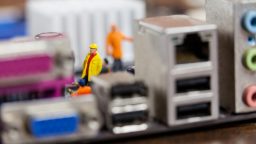The concept of the „smart home” has gone from being a futuristic fantasy to a practical reality, thanks to the rapid advancements in technology. At the heart of this transformation is the Internet of Things (IoT), which is revolutionising the way we live in our homes. But what exactly is IoT, and how is it changing the dynamics of modern living? Let’s dive into how IoT is reshaping the smart home landscape and what it means for homeowners.
What is IoT?
The Internet of Things (IoT) refers to the network of physical devices that are connected to the internet and can communicate with each other. These devices range from everyday objects, like smart thermostats, refrigerators, and light bulbs, to more advanced systems like security cameras and home assistants. The beauty of IoT lies in its ability to allow these devices to collect and exchange data, making homes more efficient, secure, and user-friendly.
By connecting various devices to the internet, IoT enables them to work together seamlessly, creating an ecosystem where users can control and monitor their home environment from a smartphone or other connected devices. With IoT, even the simplest home appliances can be “smart,” providing increased convenience and automation.
Enhanced Convenience and Automation
One of the most significant benefits of IoT in smart homes is the level of convenience it provides. For instance, smart thermostats like the Nest Learning Thermostat can automatically adjust the temperature based on your schedule and preferences. Imagine coming home from work to a perfectly heated or cooled house without ever having to touch a dial. With IoT, appliances and devices can adapt to your lifestyle, saving you time and effort.
Smart lighting systems, such as Philips Hue, are another example of IoT-enabled automation. You can control your lights remotely, schedule them to turn on and off at specific times, or even change their colour to set the mood. These devices are also energy-efficient, allowing you to manage your home’s energy consumption more effectively.
Furthermore, IoT allows for voice control through virtual assistants like Amazon Alexa, Google Assistant, or Apple Siri. This means you can ask your smart speaker to turn on the lights, play music, or adjust the thermostat without lifting a finger. For those with limited mobility or anyone looking for added convenience, voice-activated devices can be a game-changer.
Improved Energy Efficiency
Energy efficiency is a growing concern for many homeowners, and IoT is stepping in to help. With smart appliances and devices, IoT enables users to track and control energy consumption more effectively. For example, smart thermostats not only adjust the temperature to your preferences but can also learn your habits and optimise energy use. This can result in significant savings on your heating and cooling bills.
Additionally, smart plugs and outlets allow you to monitor and control the energy usage of various appliances. You can set schedules for devices to turn on or off automatically, or use sensors to turn off lights when rooms are empty. These small but effective changes can help reduce unnecessary energy consumption, leading to lower utility bills and a smaller carbon footprint.
Home Security and Safety
Security is another area where IoT is making a big impact. IoT-powered home security systems, including smart cameras, doorbells, and motion sensors, provide homeowners with real-time monitoring and remote access. For instance, a smart doorbell like the Ring Video Doorbell allows you to see who’s at your door and speak with visitors, all from your phone—whether you’re home or not.
Motion sensors can detect unusual activity and send instant alerts to your phone, while smart locks provide an added layer of security by allowing you to lock or unlock doors remotely. Many of these systems can also be integrated with other IoT devices, such as lighting systems, to create a more robust security solution. For example, your lights can be set to automatically turn on if motion is detected outside your home, simulating the appearance of someone being home, even when you’re away.
In addition to security, IoT devices can also help with safety. Smoke detectors and carbon monoxide alarms can be linked to your smartphone to provide immediate alerts if dangerous levels are detected in your home. These systems can even provide maintenance reminders or automatic updates, ensuring your devices are always functioning correctly.
Seamless Integration and Customisation
The true power of IoT lies in the seamless integration of various devices within a smart home. Homeowners can customise their IoT-enabled environment to suit their needs and preferences. Smart hubs, like Amazon Echo or Google Home, serve as a central control point for all connected devices, allowing users to manage everything from lighting to security with voice commands or through a smartphone app.
For example, you could set up a „Good Morning” routine, where your smart lights gradually brighten, your thermostat adjusts to your preferred temperature, and your coffee machine begins brewing—all at the same time. The possibilities for customisation are endless, allowing homeowners to create a personalised smart home experience that caters to their daily routine.
Moreover, IoT systems often work with third-party devices, offering greater flexibility in terms of brand compatibility. As the IoT ecosystem continues to grow, new devices and integrations are constantly being introduced, meaning that homeowners can keep adding to their smart home setup over time.
Challenges and Considerations
While IoT offers numerous benefits, there are some challenges and considerations to keep in mind. One of the main concerns is security. As more devices become connected to the internet, there is an increased risk of cyberattacks. Hackers may attempt to access personal data or take control of smart devices. To mitigate these risks, it’s essential to ensure that devices are regularly updated with the latest security patches and use strong, unique passwords for each device.
Another consideration is compatibility. Not all IoT devices are compatible with each other, and setting up a truly seamless smart home can sometimes require devices from the same brand or platform. It’s important to do your research before investing in a smart home ecosystem to ensure that all the devices you purchase can work together effectively.
Conclusion
IoT is undoubtedly revolutionising the way we live, and its impact on smart homes is undeniable. By providing enhanced convenience, energy efficiency, security, and customisation, IoT is making homes smarter and more responsive to the needs of their inhabitants. As technology continues to evolve, the future of smart homes powered by IoT looks even more promising, offering homeowners greater control, comfort, and peace of mind. While there are challenges to address, the benefits of IoT in the home are clear, making it an exciting time for anyone looking to embrace the future of living.





